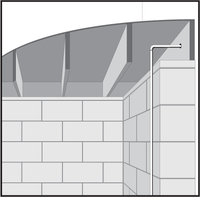Rim Joists Can Be Source of Energy Loss
(Click the image below to view a high-resolution image that can be downloaded)
With heating and cooling costs fluctuating, many people are looking for ways to reduce home heating loss and cut their heat bills.
“While the walls in homes generally are insulated, an area that is often overlooked is the rim joist,” says Carl Pedersen, North Dakota State University Extension Service energy educator. “Everyone knows walls need to have insulation. Basements are being insulated more often, but the rim joists are often overlooked.”
The rim joist is the part of a home where the framing meets the foundation (the wood meets the concrete).
Many states’ building codes require rim joists be insulated. However, North Dakota does not have such a requirement, so homeowners must make sure their rim joists are insulated.
To determine if the rim joists in your home are insulated, go into your basement or crawl space and look up. If you see the wood framing without insulation, that means you are unnecessarily losing heat from your house. Wood and concrete are very poor insulators.
Before insulating, make sure to seal any air leaks. Since the wood framing does not make a perfect seal with the foundation, air often leaks in between these gaps and can cause significant increases in the heating bill. The ideal situation is to caulk these areas during construction to close off the majority of the air leaks and then install insulation, according to Pedersen.
A quick and easy way to determine if air is leaking from your rim joists is to use an infrared thermometer. The thermometer uses a beam that allows you to determine temperature differences from a distance and can tell you quickly if air is leaking around your rim joists.
You can purchase your own thermometer for around $50. You also can borrow one and get tips on where to look for heat loses in your home from your county Extension office. Contact your local Extension office for more information.
If your rim joists are not insulated, you have three main types of insulation you can use: fiberglass batts, extruded polystyrene (rigid) and expanding foam. They each have advantages and disadvantages, so you will need to determine the best for your situation, Pedersen says.
Using fiberglass batts is one of the easiest methods of insulating. Simply cut the fiberglass insulation into roughly the shape of the opening and place the insulation in the gap. Fiberglass is a good insulator but is not effective at stopping air, so make sure fiberglass insulation has the vapor-retardant paper facing the heated space and tape all edges to stop air leaks.
Rigid insulation generally has a higher R-value than fiberglass, so it is a better insulator. The R-value indicates insulation’s resistance to heat flow. The higher the R- value, the greater the insulating effectiveness.
To use rigid polystyrene insulation, cut it to the shape of the rim joist opening and place the sections in the gap. Rigid insulation will cut more cleanly and easily using a power saw. After installing the insulation, caulk around the edges. Rigid insulation gives off toxic fumes when it burns, so it also needs to be covered with a 15-minute fire retarder, such as dry wall.
You need to make sure when insulating rim joists that moisture does not leak behind the insulation, resulting in damage to the foundation and framing. A good alternative is to insulate the areas with expanding foam insulation. Closed-cell expanding foam has an R-value of 6 per inch, compared with an R-value or 3 for fiberglass insulation. Expanding foam also seals air leaks and forms around any obstructions.
Foam can be installed professionally or you can do it yourself. Many home improvement stores offer do-it-yourself kits for installing foam insulation. The foam will stick to everything and can create quite a mess if you don’t follow instructions, so make sure to follow all manufacturers’ recommendations when attempting any home projects.
More information about insulating your home and how to use an infrared thermometer is available in NDSU Extension Service publication AE-1373, “Determining Insulation and Air Infiltration Levels Using an Infrared Thermometer,” which is available online at http://www.ag.ndsu.edu/pubs/ageng/structu/ae1373.pdf.
For more information on this or any other energy-related topic, consult Pedersen at carl.pedersen@ndsu.edu or (701) 231-5833.
NDSU Agriculture Communication
| Source: | Carl Pedersen, (701) 231-5833, carl.pedersen@ndsu.edu |
|---|---|
| Editor: | Ellen Crawford, (701) 231-5391, ellen.crawford@ndsu.edu |
Attachments
- PDF - This illustration shows what to look for when determining whether your home's rim joists are insulated. If you see wood framing without insulation, your home is losing heat. - (10.4912109375 kb)
- EPS - This illustration shows what to look for when determining whether your home's rim joists are insulated. If you see wood framing without insulation, your home is losing heat. - (57.275390625 kb)


